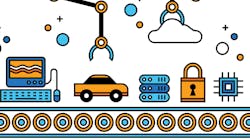Latest from 5G/6G & Fixed Wireless Access/Mobile Evolution
IT Leaders Share Their Pain Points —
Data is the currency of the 4th Industrial Revolution, just as steam, electricity, and silicon chips, were for the prior industrial revolutions. This requirement means service providers need to walk a mile in their customers’ shoes and respond to their needs with concrete infrastructure changes.
Toward that end, a recent report, Global Trend Report: How the 4th Industrial Revolution is Changing IT, Business and the World, explored global IT decision-makers pain points on behalf of Lumen. The data showed that 91% of IT decision-makers surveyed in the US believe a business’ ability to quickly acquire, analyze, and act, on data is a key factor in determining if they will be technology leaders in the future.
While these leaders know that next-generation applications are vital to business success, they also believe their current infrastructures aren’t ready to harness the power of the 4th Industrial Revolution. Nearly 3 in 4 say current IT infrastructures are not prepared to support coming increases in users, data volumes, and application performance requirements.
Interestingly, while many spent the last several years moving to the cloud, most global IT decision-makers agree that the cloud is not sufficient; 4 in 5 say that a centralized cloud model cannot support their workload demands. Why? Because their applications require high-bandwidth and ultra-low-latency network performance, and there is a need to move critical applications, workloads, and data, closer to where they are processed.
What does that mean in terms of network infrastructure evolution for network providers? Fiber. In fact, 9 in 10 global C-suite leaders believe that fiber infrastructure is essential to connect to a distributed cloud network.
What’s more, they want to bring their applications and data closer with edge compute because the applications require high bandwidth to support massive volumes of data together with ultra-low latency to support near real-time response to market challenges and opportunities. In a distributed environment, edge compute brings critical applications and data closer to where they are processed. The vast majority of global IT decision-makers say that edge compute is vital to their future. In fact, more than 90% anticipate implementing edge compute services to keep pace with the expansion of the Internet of Things (IoT) in the coming years.
These factors make edge compute seem like an obvious choice for many workloads. So why are many enterprise IT infrastructures still focused so heavily on-premises and/or in a centralized cloud? Market availability appears to be the only thing holding edge compute back: 90% of global IT decision-makers say they would move their organization’s applications from on-premises to edge compute if it was available today.
InvisiLight® Solution for Deploying Fiber
April 2, 2022Go to Market Faster. Speed up Network Deployment
April 2, 2022Episode 10: Fiber Optic Closure Specs Explained…
April 1, 2022Food for Thought from Our 2022 ICT Visionaries
April 1, 2022Then, there’s the relationship between the edge and 5G. While many people think of 5G when they think of "the edge," nearly 3 in 4 global IT decision-makers agree that 5G needs edge compute more than edge compute needs 5G.
Edge compute is the secret weapon enabling 5G according to 82% of global IT decision-makers. They say 5G needs edge compute to deliver the performance and experience necessary for their business to succeed.
However, not all global IT decision-makers are excited about 5G. Nearly 30% of global IT decision-makers and 33% of US IT decision-makers say they are skeptical about their company using 5G networks.
Security and Edge Compute
When combined with the increasing complexities of business IT environments using emerging applications and technologies, traditional perimeter-based security approaches have become obsolete. 81% of global IT decision-makers and 85% in the US say perimeter-based security is no longer sufficient for their business.
This can be daunting, especially when you’re preparing for the 4th Industrial Revolution: 68% of C-suite leaders globally say that’s what keeps them up at night.
In addition, global IT decision-makers expect data security and connectivity will become more critical as a result of the current global pandemic: 3 in 5 say security will become much more important in the wake of COVID-19, and more than half say that about data connectivity, as well.
That’s why network orchestration is so important. It ties applications together with other applications, with the data being moved and with the compute, storage, and network infrastructure underneath. Orchestration technology is evolving rapidly to use APIs to connect applications and data with network services. Software-defined networking (SDN) enables the orchestration layer to issue calls to the network, turning up new connections on the fly to wherever data needs to go, and then turning the connection back down again once that data gets there. That helps save money, makes the process work more efficiently, and enables greater flexibility.
The goal of the network is to connect to the needs of applications and workloads without manual intervention. And not surprisingly, 9 in 10 global IT decision-makers say that the seamless integration of applications and their network is a top priority.
All of these facts support one very clear point: Edge Compute is no longer an option — it is a necessity for businesses to thrive in the 4th Industrial Revolution. That translates into one critical finding for network service providers in the future: only those who transform their networks to meet their customers’ needs will secure their loyalty and their future business. n
References and Notes
This article is adapted from the Lumen white paper Global Trend Report: How the 4th Industrial Revolution is Changing IT, Business and the World. This report is based on a Quadrant Strategies online quantitative survey with 2,464 Senior IT Decision-Makers and C-suite executives from large and midsize organizations in the US, UK, Germany, France, Australia, Argentina, Colombia, Brazil, Singapore. and Japan. To download this white paper, visit https://assets.centurylink.com/is/content/centurylink/global-trend-report-4th-industrial-revolution-4IR.
For more information, visit https://www.lumen.com/en-us/home.html. Follow Lumen on Twitter @lumentechco.
Like this Article?
Subscribe to ISE magazine and start receiving your FREE monthly copy today!













